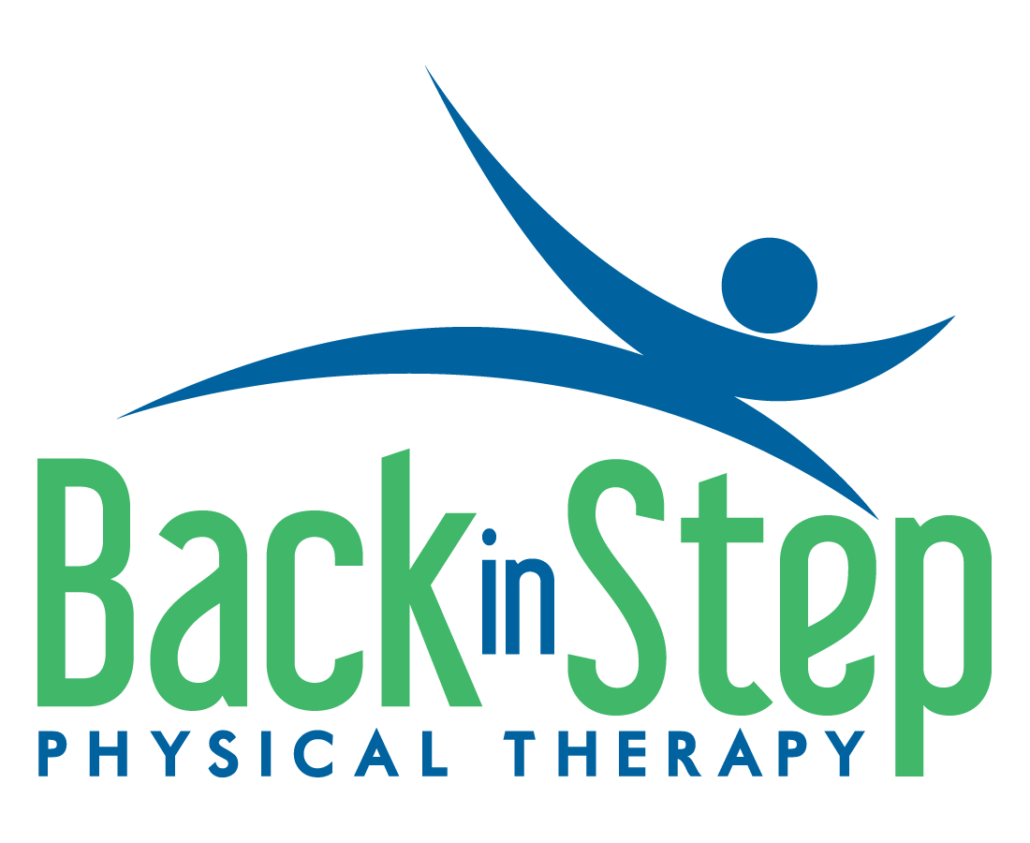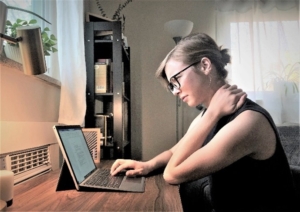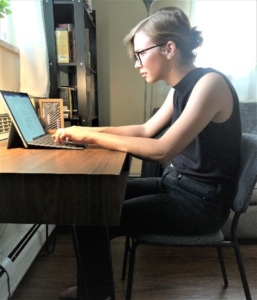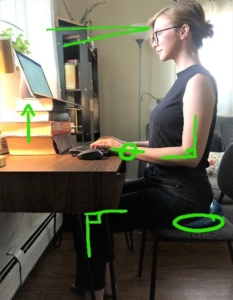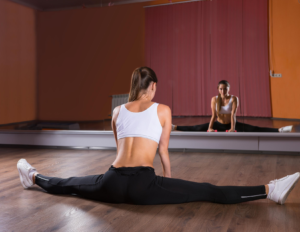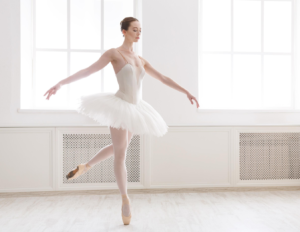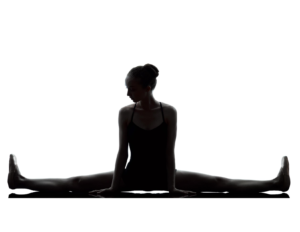Healthy Ways for Working from Home: Breaks
Part 1 of this three-part series focused on setting up an ergonomic office space built around your unique best posture while working from home. Check out this post here for healthy tips on workspace set up and intentional movements to try while you work. This next part of this series will focus on practical and healthy ways to minimize pain by incorporating breaks throughout your workday.
Take Breaks
Before the pandemic and the shift to working from home, you may have had mandatory breaks incorporated into your workday. Now that you’re in charge of scheduling, it may be tempting to power through work duties without breaks, but this can lead to body discomfort and burn out.
As a grad student, I’ll be the first to admit that it’s difficult to take active and healthy breaks while I am in the middle of online classes and assignments. I typically find myself crawling over to the couch to lay down and stretch my back while I indulge in an episode of my favorite TV show. I don’t know about you, but I never feel truly pain free, refreshed, or motivated to get back to work after a break like that. Let’s take a look at some ideas for rejuvenating breaks that will help your body and mind while working from home.
…For Your Body
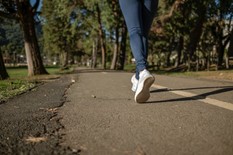 So, why take breaks? Studies show that sustained sitting can actually cause increased levels of pain, fatigue, and muscle stiffness in your back.1,2,3 Though the thought of taking breaks to move and change positions seems simple, it can be difficult to do without an environmental cue to remind you. Naturally occurring breaks could have looked like visiting a friend at a different desk, walking further to the restrooms, or maybe grabbing a cup of coffee on your way to fax a document. Now that you are working from home, start thinking of some ideas to incorporate these natural actions into your day. A great trick is to adapt your environment and add in some tasks that require you to get moving!
So, why take breaks? Studies show that sustained sitting can actually cause increased levels of pain, fatigue, and muscle stiffness in your back.1,2,3 Though the thought of taking breaks to move and change positions seems simple, it can be difficult to do without an environmental cue to remind you. Naturally occurring breaks could have looked like visiting a friend at a different desk, walking further to the restrooms, or maybe grabbing a cup of coffee on your way to fax a document. Now that you are working from home, start thinking of some ideas to incorporate these natural actions into your day. A great trick is to adapt your environment and add in some tasks that require you to get moving!
A randomized controlled trail study in 2018 looked at the actual plausibility of taking active breaks during the 8-hour day for a group of office workers.1 The article concluded that people were more successful adding in movement if it was related to a specific job task. For example, people used phone calls as a reminder to stand up. They were also more likely to take breaks for walking if it could be incorporated into their daily routine, like going to the fax machine, printer, or even the restroom. Internal cueing (listening to the body) was another trick that these office workers used to remind themselves take breaks to stretch and move.
Experiment!
How could you set up your home office to encourage breaks for walking? What cues could you use to remind you to stand up more and sit less? One idea is to use your lunch break for a walk around the neighborhood or do a little yoga session!
Muscle Rolling
An additional idea for a body break is to incorporate some stretching and muscle rolling movements during your lunch or 15-minute breaks. Muscle rolling is a great way to self-massage your spine and trap muscles, which typically get stiff and uncomfortable during lengthy bouts of working. A recently published article by Kett et al2 supports muscle rolling breaks to manage painful effects of sustained sitting.
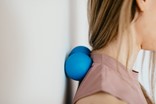 They found that 8 minutes of muscle rolling with a ball or bar was effective at improving symptoms in the back. This is because a slumped posture can cause muscle pain by increasing tone (contraction state) of muscles.2 The stiffness is caused by the tissue itself due to micro trauma of the stretched-out ligaments, disks, and capsules combined with muscle spasms that restrict blood flow.2 The muscle roller helps by breaking up the connections between stiff muscle cells, allowing for increased temperature to bring blood flow back into the spastic muscle. This technique can be used as one of your short active breaks to decrease muscle stiffness and promote relaxation!
They found that 8 minutes of muscle rolling with a ball or bar was effective at improving symptoms in the back. This is because a slumped posture can cause muscle pain by increasing tone (contraction state) of muscles.2 The stiffness is caused by the tissue itself due to micro trauma of the stretched-out ligaments, disks, and capsules combined with muscle spasms that restrict blood flow.2 The muscle roller helps by breaking up the connections between stiff muscle cells, allowing for increased temperature to bring blood flow back into the spastic muscle. This technique can be used as one of your short active breaks to decrease muscle stiffness and promote relaxation!
Check out our YouTube videos for how to muscle roll with a foam roller:
…For Your Mind



Intuition and uncomfortable body signals may indicate to us to stand up or move around, but mind breaks are just as important as body breaks. A beneficial place to start is to find out what you like to do that is peaceful and relaxing. For example, I enjoy playing my ukulele or calling a family member during my lunch break while working from home. Prioritizing psychosocial health is not only important for helping with the day, but it also plays a role in managing pain. A recently published article in 2020 looked at the relationship between chronic pain and depression levels.3 They concluded that managing your mind and social health can minimize depression, which actually has a significant effect lowering chronic neck and lower back pain and vice versa.
Here are some mindful ideas to try during your breaks:
- Check out our Work from Home Kit!
- Try some exercises for relaxation, stress release, and grounding. Check out our YouTube video on some techniques to try.
- Eat a healthy snack or create your favorite meal. Follow us on our Pinterest and Instagram for some of Dr. Alyssa’s favorite healthy recipes.
- Do something creative. Play your favorite music, dance like nobody is watching, or give painting a go!
- Prioritize your social health. Video chat a loved one or maybe even write a letter to someone you have been meaning to reach out to.
- For more ideas, please check out our blog on mindfulness here.
In our first blog we talked about ways to set up your home office to minimize joint pain and unnecessary muscle activation. We now have gone over some tips for healthy body and mind break ideas to minimize pain while you are working from home. Our next blog will focus on your overall health and overcoming health obstacles while working from home. If you have additional questions, Back in Step Physical Therapy is here for you! Please contact us to schedule an online or in-clinic consultation.
Follow our social media platforms for additional health tips:
Guest Blog by Haley Tirado, SPT
Haley Tirado is a second year Student Physical Therapist who attends the University of Colorado Anschutz Medical Campus. She is a student worker who participates in conducting physical therapy research studies with the RESTORE Research Team at UC Anschutz. Haley currently works as an intern for Back in Step Physical Therapy.
References:
1. Stephens SK, Eakin EG, Clark BK, Winker EAH, Owen N, LaMontagne AD, Moodie M, Lawler SP, Dunstan DW. What strategies do desk-based workers choose to reduce sitting time and how well do they work? Findings from a cluster randomised controlled trial. International Journal of Behavioral Nutrition and Physical Activity. 2018, 15:98. https://doi.org/10.1186/s12966-018-0731-z.
2. Kett AR & Sichting F. Sedentary behaviour at work increases muscle stiffness of the back: Why roller massage has potential as an active break intervention. Applied Ergonomics. Jan 2020, Vol 82: 102947. https://doi.org/10.1016/j.apergo.2019.102947.
3. Angst F, Benz T, Lehmann S, Wagner S, Simmen BR, Sandor PS, Gengenbacher M, Angst J. Extended overview of the longitudinal pain-depression association: A comparison of six cohorts treated for specific chronic pain conditions. Journal of Affective Disorders. 1 Aug 2020, Vol 273: 508-516. https://doi.org/10.1016/j.jad.2020.05.044.
